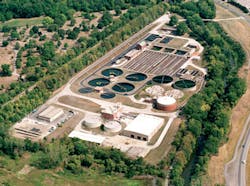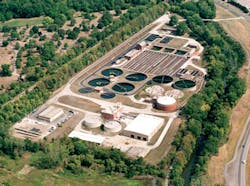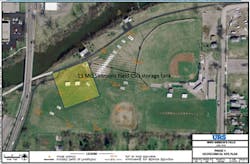Upgrades: Can they be Environmentally Positive and Affordable?
By Fredric Andes
Many communities around the country are facing increased regulatory requirements under the Clean Water Act (CWA), which could require substantial, costly upgrades to their treatment plants, sewer systems and other operations. However, when those requirements are imposed, it often seems that the question of whether those costs are affordable to a city or district -- or to ratepayers -- does not enter into the decision. Further, it frequently appears that the amount of environmental benefit that will actually be derived from these upgrades is not considered at all. So, what can communities do to achieve a result that protects water quality while also shielding the community from unreasonable financial burdens?
Fortunately, recent Environmental Protection Agency (EPA) policy changes provide communities with some new opportunities to work with regulatory agencies to shape better results, which can be a "win-win" for everyone concerned.
Over the last several years, the U.S. Conference of Mayors has engaged in a dialogue with EPA about how the Agency and states address municipal compliance issues. The primary concern voiced by the Mayors has been that EPA -- and its regions, in particular -- has not made sufficient use of the flexibility afforded by its own regulations and guidance.
Communities have been told, for example, that their programs to address sewer overflows must cost at least 2 percent of the median household income (MHI) for the community and that the control program cannot take more than 20 years to implement. In fact, the relevant EPA rules and guidance do not provide such inflexible commands. Rather, they provide communities with the opportunity to fashion programs that make sense from both an economic and environmental standpoint, but that is not the way the requirements have been imposed in many communities.
To improve this situation, it was not necessary to change EPA's rules or guidance. Rather, all that was needed was leadership from EPA Headquarters (HQ) to ensure that what is happening on the ground matches what is written in the Agency's policies. As part of this effort, EPA HQ has issued several memoranda to the Regions and states clarifying its policy on several important issues. Some of the key topics covered in these documents are integrated planning and affordability.
With regard to integrated planning, EPA has stated that a community, if it chooses, can develop a plan that integrates multiple clean water-related obligations. Too often in the past, a community has had to contend with many separate regulatory requirements, none of which are coordinated with each other. This has resulted in unrealistic schedules for implementation, since each requirement is designed as if the town must meet only that obligation and no others. The lack of coordination can also mean that a community is stressed financially by one control requirement, while more requirements are imposed on top of them, ignoring the fact that the city has no remaining funding after investing in the first set of controls.
Also, and very importantly, the lack of integration means that while identifying what controls need to be implemented and when -- or which need to be applied at all -- no one considers how much environmental benefit will be derived from each control or how the requirements could be implemented and sequenced to provide the most benefit.
But none of that is mandated or even necessary.
The Agency policies allow for various requirements to be considered together, and EPA's Integrated Planning Framework (IPF) provides a vehicle and a structure for accomplishing that goal.
A good example of how integrated planning can help a community develop good solutions is the case of Lima, Ohio. Lima, a town of about 35,000 people in northwest Ohio, has suffered from significant economic stress over the last decade. The median household income (about $26,000) is well below the national average, and about one-third of the residents are below the poverty line.
Yet, Lima has been faced with a number of very costly requirements to upgrade its treatment plant and sewer system. If those requirements were implemented in a non-integrated way, they could very well bankrupt the town without providing substantial environmental benefit. Instead, Lima was able to use EPA's IPF to develop a plan that addresses those control requirements in a coordinated way.
The schedule for Lima -- approved by the City, EPA and the State of Ohio -- allows the town to implement the controls over a 24-year timeframe, which accounts for its bonding cycles so that adequate financial resources are available at each step. Also, the order in which controls will be applied recognizes that some will provide more environmental benefit than others and therefore should be prioritized.
In this case, that means Lima will complete treatment plant upgrades first, then work on changes to its combined sewer system, followed by upgrades to its separate sewer system. This process will help ensure that the requirements, considered together, are affordable for the city's residents and also provide the maximum environmental benefit for the resources expended.
In addition to issuing guidance on integrated planning, EPA has also clarified its policies on affordability issues. In many cases, the Agency has judged whether a community can afford controls by applying a very rigid formula specified in its guidance. This formula assesses the city's compliance costs to determine if they would exceed 2 percent of MHI. If so, the community could be eligible for relief on the level of control, the schedule, or both.
Unfortunately, this formula does not accurately judge the real financial impact on the city and its ratepayers, which depends on many more factors than just a comparison of costs to MHI. For a truer sense of real impacts, one must also consider actual sewer rates charged and how they would change. It is also important to review the possible impacts of spreading out the schedule over a longer time period in order to provide the district more time to raise the money for the work. And finally, it is critical to consider the impacts on those with lower incomes who can least afford the increases in rates that will result from the new requirements.
It is too early to know how well EPA's initiatives on integrated planning and affordability will work in practice, although Lima's plan is a step in the right direction. If these initiatives are implemented successfully in the Regions, there could be real progress in promoting affordable municipal upgrades that also make a difference in improving water quality.
If, however, the EPA initiatives are unsuccessful, there may be a need for legislation to amend the CWA. In fact, the U.S. Conference of Mayors has suggested some concepts that could be included in that legislation, and there will likely be debate on these issues on Capitol Hill in 2015. Hopefully, whether through EPA policies or legislative changes, the result can be a reasonable regulatory structure that promotes affordable, environmentally beneficial upgrades.
About the Author: Fredric P. Andes is a partner in the Chicago and Washington, D.C., offices of Barnes & Thornburg LLP and the leader of the firm's water team. Mr. Andes is involved in counseling and litigation on issues arising under various federal and state environmental laws, with a special emphasis on Clean Water Act matters.
More WaterWorld Current Issue Articles
More WaterWorld Archives Issue Articles



